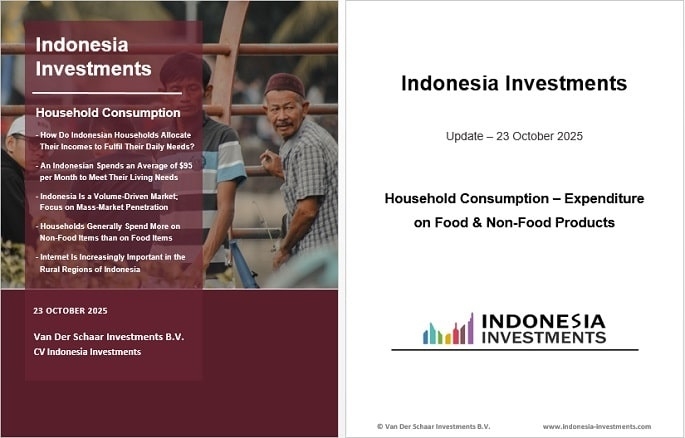Household Consumption in Indonesia – Expenditure on Food and Non-Food Products
For (potential) investors or business-owners it’s important to understand the socio-economic conditions of a country to optimize chances of success when pursuing an investment project. Among the crucial matters is the expenditure and consumption patterns of the people as these data can help to give insight into whether households have the financial resources at their disposal to buy specific products or services.
Based on the Executive Summary of Consumption and Expenditure of the Population of Indonesia (March 2025) that was released by Indonesia’s Statistical Agency (BPS) in early October 2025 we were able to make an interesting overview of Indonesians’ welfare and how they allocate their income to fulfil their daily needs. It is interesting to add that BPS uses an expenditure approach (rather than an income approach) for data collection as this is considered easier to obtain, more stable, and more accurate in reflecting the true economic conditions of the community. Moreover, measuring incomes for those individuals who work in the big informal sector (or with irregular earnings) tends to be more challenging, as respondents may report inaccurately.
It is also important to stress that the dynamics of household expenditure evolve in tandem with economic, social and technological developments. Various factors such as inflation, fluctuations in food and non-food commodity prices, subsidy policies, and lifestyle shifts (driven by digitalization) are always influencing the consumption behaviour as well as consumer choices. Subsequent changes are reflected not only in spending on basic needs (like food or housing), but also in spending on education, health and recreation. By understanding these consumption patterns, investors and business-owners can identify new expenditure trends, and thus are able to adjust their strategies accordingly.
Typically, households have two ways of using income: (1) by spending (part of) their income on goods and services (‘consumption’), and (2) by saving (the remainder) for future usage. Here, we focus on consumption in the present (point 1).
Meanwhile, household consumption can be divided into: (a) food, and (b) non-food consumption. Food consumption ranks as the most important category because it is the primary source for survival. However, there is another distinction needed here, namely between the ‘non-discretionary (necessity) food goods’ and ‘discretionary (non-essential/luxury) food goods’.
Non-discretionary (necessity) goods are considered inelastic, meaning that even if the household's income falls or the price increases slightly, the consumption of these items generally remains stable because people cannot easily stop buying these food products (as these are needed to live, such as meat, vegetables and rice).
However, discretionary (non-essential/luxury) goods are considered elastic. Their consumption is highly sensitive to changes in disposable income. So, if a household budget gets tight (income falls), these items are typically the first to be cut (because these items are not necessary to survive, such as lobster, wine, cakes, pre-cut fruits, and snacks). Conversely, when income rises, spending on these discretionary food items increases sharply.
In terms of non-discretionary (necessity) food product, BPS specifically focuses on broiler chicken in order to assess consumption patterns. Broiler chicken is selected because of its crucial role as a primary source of animal protein and its significant contribution to household consumption patterns in Indonesia. Demand for broiler chicken continues to grow in line with population growth, urbanization, and rising public awareness of nutrition. Moreover, its relatively affordable price compared to other sources of animal protein has made broiler chicken a preferred choice across various segments of Indonesian society.
[...]
These are the first two pages of the article (which consists of 35 pages). If you want to read the full article (an electronic report, PDF, in English) you can order it by contacting us through email and/or WhatsApp:
- info@indonesia-investments.com
- +62(0)882.9875.1125
Price of this report:
Rp 45,000 (or equivalent in other currencies)

